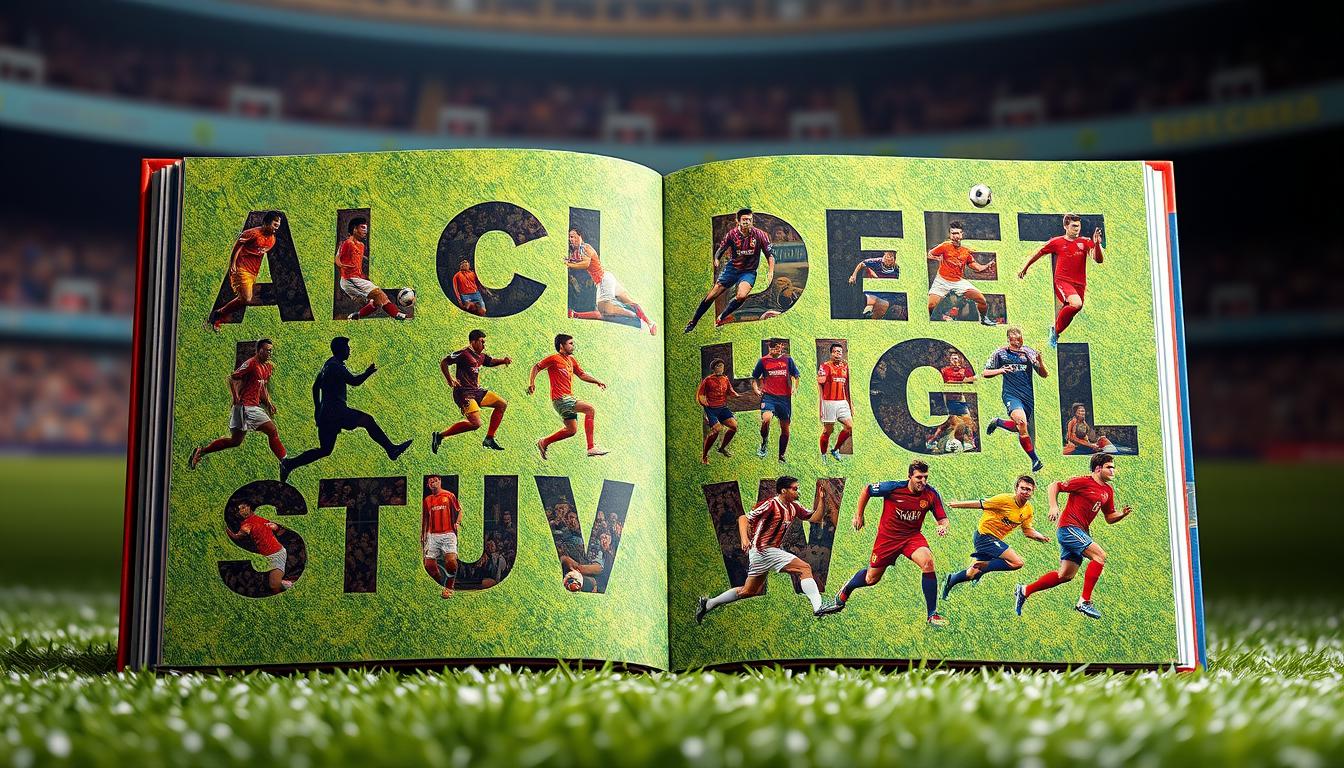Learn the Soccer ABCs for Kids: A Step-by-Step Guide

What if mastering the alphabet could feel like scoring a game-winning goal? The soccer legends alphabet turns learning into an adventure, blending iconic players like Maradona and Messi with vibrant letter art. Designed for young readers and adults alike, this approach makes every page a celebration of skill, teamwork, and discovery.
This step-by-step guide isn’t just about letters—it’s a doorway to inspiring stories. Each biography shares fun facts that spark conversations, like how legends overcame challenges or practiced their craft. Whether you’re a parent, coach, or fan, the content balances simplicity with depth, perfect for ages 6–12.
Key Takeaways
- Combines alphabet learning with soccer history through custom artwork.
- Features legends like Maradona to engage young minds and adult fans.
- Biographies include discussion-worthy facts for family or classroom use.
- Balanced reading level for elementary and middle-grade readers.
- Encourages teamwork and perseverance through relatable role models.
Getting Started with Soccer ABCs for kids
Imagine turning letter practice into a team sport where every page scores a learning goal. The secret lies in combining letter art featured designs with bite-sized stories of sports heroes. Let’s break down how to kick off this journey smoothly.
Gathering Essential Materials
First, grab the hardcover book (8.2 x 8.1 inches) – its sturdy build survives energetic hands. Pair it with simple tools like colored pencils or sticky notes for interactive fun. Here’s a quick checklist:
| Essentials | Purpose | Format |
|---|---|---|
| Alphabet Book | Showcases version letter sans-serif art | Reinforced Hardcover |
| Writing Tools | Trace upper lower case letters | Markers or Crayons |
| Discussion Prompts | Explore biographies featured legends | Printed Cards |
Setting Clear Learning Goals
Aim to master one letter daily using both case version letter styles. Use the 60-80 word biographies to spark chats about perseverance. For example, ask: “How did this player handle setbacks?”
Keep sessions short – 15 minutes works best. Rotate between tracing lower case version letters and discussing fun facts. This balance keeps young minds engaged without overwhelm.
Step-by-Step Instructions for Teaching the Alphabet
Discover how blending vibrant visuals with athlete stories makes letters unforgettable. Start by showcasing custom letter art that mirrors each legend’s personality. Bold designs, like a flaming “F” for Ferenc Puskás or a lightning-shaped “L” for Lucy Bronze, create instant connections between shapes and stories.

Introducing Each Letter with Letter Art
Display one letter daily using its artistic version. Ask learners to trace both upper and lower case forms while discussing the athlete’s name. For example: “This ‘M’ honors Marta – she scored 115 goals for Brazil! Can you write her name in lowercase?”
Using 60-80 Word Biographies of Soccer Legends
Read the short bios together, focusing on interesting facts that encourage curiosity. Did You Know? Pelé practiced with grapefruits as a child. Pose questions like, “Why might he use fruit instead of a ball?” to spark research. Keep language clear but mature references – phrases like “tactical genius” expand vocabulary gently.
Incorporating Upper and Lower Case Versions
Use side-by-side examples to show letter variations. Create matching games: “Find the lowercase ‘r’ that looks like Ronaldinho’s jersey number.” Reinforce recognition through weekly quizzes with reading level suitable for ages 6–12. Celebrate progress with sticker charts shaped like trophies or soccer balls.
Engaging Young Learners with Soccer and Alphabet Fun
What if letters could leap off the page like a striker aiming for the net? The legends alphabet transforms static symbols into dynamic art, merging bold colors with athlete-inspired designs. Each page becomes a visual playground where learning feels like discovering hidden treasures.
Using Bold Illustrations and Custom Letter Art
Vibrant visuals act as magnets for young eyes. A fiery “Z” shaped like Zinedine Zidane’s iconic jersey number sparks instant recognition. These custom letter art pieces do double duty – teaching letter shapes while introducing sports heroes through color and creativity.
Try these interactive ideas:
- Play “Guess the Legend” using silhouette clues in the artwork
- Challenge learners to recreate letters with craft supplies
- Match uppercase and lowercase versions using player stats
Selecting Reading Material for Ages 6-12
The biographies featured strike a perfect balance – simple enough for early readers, yet rich with details for older students. Sentences average 10-12 words, using sophisticated words like “determination” and “teamwork” in relatable contexts.
Key features make this suitable children’s material:
- 60-80 word stories with clear beginning-middle-end structure
- Pronunciation guides for international player names
- Comparison charts showing uppercase and lowercase case version letters
Parents love how the featured legends bridge generations. A 7-year-old tracing Cristiano Ronaldo’s “CR7” logo while Grandma shares World Cup memories? That’s learning magic.
Wrap Up: Tips for Successful Soccer ABCs Learning
Turn letter drills into victory laps with these final strategies. Review upper and lower case versions daily using the book’s bold artwork – trace Zlatan’s zigzag “Z” or Megan Rapinoe’s flowing “M.” Keep sessions lively by asking, “What surprised you about this legend’s story?”
Spark discussion research with the interesting facts in each bio. Did you know some players practiced barefoot? These legends intended details make history relatable. Encourage learners to share their favorite discoveries.
Adjust the reading level as needed – simplify terms for younger children years 6-8, while older readers explore contain sophisticated concepts like sportsmanship. The mix ensures everyone grows.
Celebrate progress! High-fives work wonders when a child nails tricky letters. Remember, the material’s durable pages withstand enthusiastic hands – perfect for groups. Families nationwide love how it engages enjoyed boys, girls, and including adults alike.
Ready? Grab your book, gather your team, and let those letters shine!
